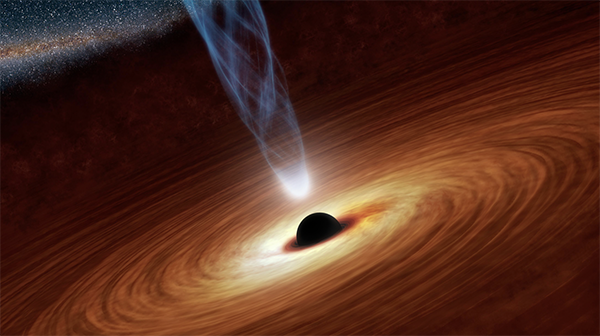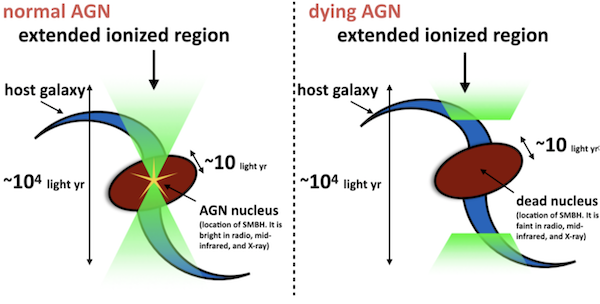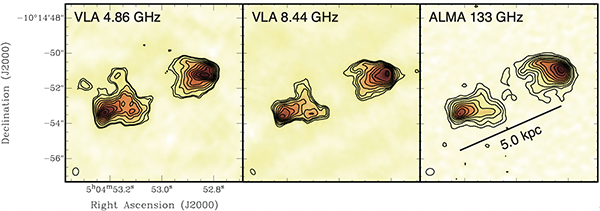NEWS
Active Galactic Nucleus caught in the act of "dying" 〜light echo delivers the information before the death〜

Figure 1. Artist's concept image of a supermassive black hole at the center and the black hole is surrounded by the falling gas, so-called accretion disk. The jet is also shown launched from the black hole.(※NASA/JPL)
Research summary
In the universe, there are large number of galaxies and there is at least one supermassive black holes (SMBHs1)) in the center of each galaxy. The mass of SMBH is huge: around millions to billion-times the mass of the Sun, but the origin of SMBH growth is still largely unknown. One way to tackle this problem is observing a population of galaxies called active galactic nuclei (AGN), where the SMBHs are in rapidly growing phase because of the mass accretion from the surrounding area. AGN are so bright by releasing the gravitational energy of the accreting matters and it makes AGN a very popular observing target. However, nobody knows how AGN activity has been ignited from the quiescent SMBH, and also how AGN activity will be quenched. Such a ``newly-born'' or ``dying'' AGN has not been discovered yet.
We have serendipitously found a dying AGN in a galaxy called Arp 187 by carefully checking the surrounding environment of SMBH with different physical scale from less than 10 light year to 1 million light year. Future observations will enable us to step forward our understanding on the quenching environment of AGN.
Research content
There are tremendous number of galaxies in the universe. Astronomers in the last 30 years have discovered that once we look deep into the center of each galaxy, at least one supermassive black holes (SMBHs) are ubiquitously sitting there, and the mass is overwhelmingly huge: from 1million to 10 billion times the mass of the Sun. Astronomers have been tackling how SMBHs have acquired their mass and how SMBH has stopped their growth, but we still do not have a clear answer yet.
Active galactic nuclei (AGN) is one of the key population, which might give us a clue to solve the SMBH growing problem. AGN are so bright because the SMBHs are in rapidly growing state due to the gas inflow (termed as "accretion") from the surrounding area as shown in Figure 1, and the accreting gas release the gravitational energy and it turns into the radiation. The luminosity of AGN reaches up to 1 trillion times the luminosity of the Sun, which makes us to easily observe AGN even they are located in the distant universe. Since AGN are result of accretion of matter into the SMBH, they are primary targets for us to investigate how rapidly SMBH is acquiring the mass.
Still, we know very little on the SMBH growth, especially on the ignition/shut-down mechanism of AGN: how silent SMBH becomes AGN and how AGN again returns to a dormant SMBH again. Considering that there is maximum mass limit for SMBH (~100 billion times the mass of the Sun), AGN must shut-down their activity at some point, but finding such shut-down AGN has been very difficult because of the SMBH becomes dormant very rapidly after the quenching of AGN.
We here report the observational discovery of such a ''dying'' AGN. This discovery happened serendipitously of the target galaxy Arp 187. Since AGN emits large amount of high energy photons which are enough to ionize2) the gas of the surrounding area up to 104 light years, and AGN also emits energetic jet extending over 104 light years. These ionizing regions or jets are often recognized as a good indicator of AGN since it is hard for other astronomical objects to produce such extended structure. We observed a galaxy called Arp 187, which clearly shows a jet-lobe using ALMA3) and VLA4) radio observatories in order to investigate the jet properties and morphologies, but we could not find a radio core which is ubiquitously associated with AGN core. This suggests that the central engine of AGN might be fading. We have also started a multi-wavelength AGN indicators which traces different physical scales. As shown in Figure 2, the result was that we see clear AGN indicators in large physical scale (>104 light year), but we find no clear AGN signatures in small physical scale (<10 light year). This discrepancy can be naturally described if we assume that AGN activity has been recently quenched (and therefore small scale AGN indicators suddenly disappeared), but large scale AGN indicators are still visible because it takes over 104 years for photons to arrive at the edge of such extended AGN component. This method is called as a "light echo" and has been actually applied to some AGN and discovered AGN caught in the act of "fading", but we have found for the first time that the central engine is completely dead, but the surrounding area is very bright yet. This gives us an important information that the turn-off of AGN occurs within the timescale of 104 year.
We will continue the high-spatial resolution follow-up observations of Arp 187 to investigate the gas inflows and outflows, which might clarify how the shut-down of AGN activity (=shut-down of gas accretion to SMBH) had occurred. We are also planning to search more dying AGN by using different physical scale AGN signatures.
Journal
Journal: The Astrophysical Journal
Title: Discovery of Dying Active Galactic Nucleus in Arp 187: Experience of Drastic Luminosity Decline within 104 yr
Author: K. Ichikawa, J. Ueda, H-J. Bae, et al., 2018, ApJ, 870, 65
DOI: 10.3847/1538-4357/aaf233
Figures

Figure 2. The observational difference between a standard AGN (left) and a dying AGN (right) discovered by our study (revised figure based on Schawinski et al. 2015). The standard AGN has extended ionized region with the size of ~104 light years, and the nucleus is bright in the radio, mid-infrared, and X-ray band. On the other hand, in the dying AGN, the nucleus is very faint in any wavelength bands because the AGN activity is already dead, while the extended ionized region is still visible for ~104 light year since it takes ~104 years for the light to cross the extended region.

Figure 3. The radio band images of Arp 187 obtained by VLA and ALMA telescopes(from left to right, the frequency of image is at 4.86 GHz, 8.44 GHz, and 133 GHz). Each panel shows clear bimodal jet lobes with the separation of 5.0 kpc, but the central nucleus is faint or non-detection.(※ obtained from Ichikawa et al. 2019, Figure 1).
Words
(1) Supermassive black holes (SMBHs)
There is at least one supermassive black hole in the center of every galaxy hosting the bulge. The BH mass reaches from 106 to 1010 times the mass of the Sun, and the origin of the mass is still one of unresolved problems in Astronomy.
(2)Ionization
Atoms are composed of one nucleus and electrons bounded to the nucleus. Ionization is the process for atoms to be charged by losing electrons. The existence of such ionized atoms is good evidence of the existence of high energy photons, which make the bounded electrons into the free one over the bounding energy of atoms.
(3) ALMA
Atacama Large Millimeter/submillimeter Array (ALMA) is currently the largest radio interferometry in the Atacama, Chile. Thanks to its supreme spatial resolution (<0.1 arcsec) and sensitivity, ALMA is often selected as the primary telescope in the research of detailed morphologies of galaxies in the distant universe. In this study, ALMA helped us to spatially resolve the jet lobe and the core, and the core was non-detection even with ALMA, which gives us the strong upper-bound of its faintness.
(4) VLA
Karl G. Jansky Very Large Array (VLA) is a radio interferometry in New Mexico, USA. VLA covers a relatively lower frequency range compared to ALMA. In this study, the lower frequency band has some advantage than ALMA for observing the pure (Synchrotron) radiation from the jet lobe without worrying about the contamination from the cold dust emission from the galaxies.
Contact:
Kohei Ichikawa
Assistan Professor at
The Frontier Research Institute for Interdisciplinary Science
E-mail:k.ichikawa * astr.tohoku.ac.jp
(Replace * with @)




